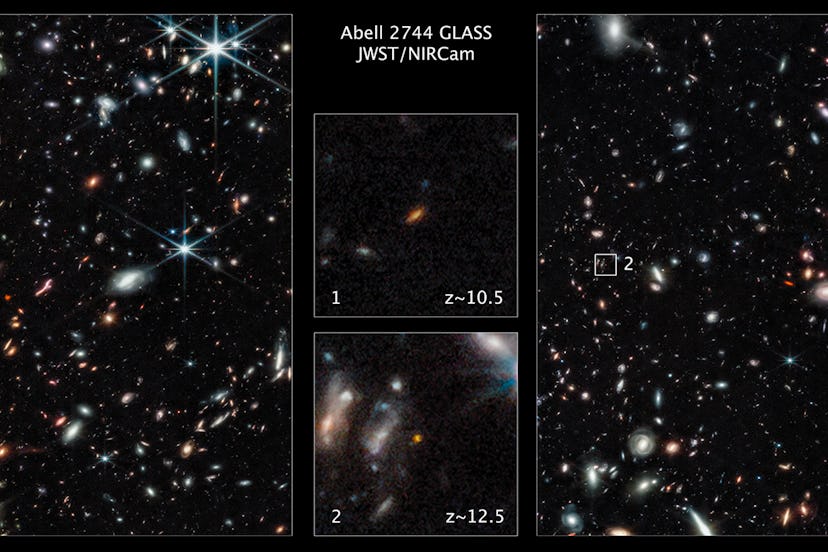JWST Photos Might Change The Universe's Timeline In A Major Way
NASA recently shared two new images taken from the telescope that has the potential to change everything that we know about our universe.

The James Webb Space Telescope (JWST) has repeatedly proven that the technology is incredible, and with it, scientists are learning so much more about our universe—and beyond. NASA recently shared two new images taken from the telescope that have the potential to change everything that we know about our universe.
On November 17, NASA tweeted photos of two early galaxies the JWST recently found. “This is a whole new chapter in astronomy,” the tweet read. Of the two new galaxies discovered, one “may contain the most distant starlight ever seen,” NASA noted. “These 2 unexpectedly bright galaxies could fundamentally alter what we know about the very first stars.”
Can you explain what we see in these photos like we’re five years old?
For most of us looking at these photos, they don’t seem all that spectacular. There are no bright, bold colors, explosion-looking dust, or weird objects, or astounding spiral galaxies. But they’re genuinely astounding marvels of science.
First off, this is the most distant starlight that’s ever been seen, and that’s a huge deal that the telescope found this. “With Webb, we were amazed to find the most distant starlight that anyone had ever seen, just days after Webb released its first data,” Rohan Naidu of the Harvard-Smithsonian Center for Astrophysics and the Massachusetts Institute of Technology in Cambridge, Massachusetts, explained to NASA.
“Everything we see is new. Webb is showing us that there’s a very rich universe beyond what we imagined,” said Tommaso Treu of the University of California at Los Angeles, principal investigator on one of the Webb programs explained to NASA. “Once again, the universe has surprised us. These early galaxies are very unusual in many ways.”
Scientists are saying this is such a big deal because they didn’t expect to discover this, and though there would be a lot more space exploration still to come to eventually hope to find something like this. And what they found was a lot different than they expected they would eventually find.
“These observations just make your head explode. This is a whole new chapter in astronomy,” Paola Santini, fourth author of the Castellano et al. GLASS-JWST paper, said to NASA. “It’s like an archaeological dig, and suddenly you find a lost city or something you didn’t know about. It’s just staggering.”
These images prove that many unusual galaxies were “much brighter than expected,” and what they found is very different than our Milky Way galaxy or the others they’ve already discovered.
“We’ve nailed something that is incredibly fascinating. These galaxies would have had to have started coming together maybe just 100 million years after the big bang,” Garth Illingworth of the University of California at Santa Cruz, a member of the Naidu/Oesch team, said. “The primal universe would have been just one hundredth its current age. It’s a sliver of time in the 13.8 billion-year-old evolving cosmos.”
In the most layman of terms, this discovery flips how old we think this whole universe is, suggesting that stars may have started forming way earlier than expected, and our galaxy may be billions of years older than we thought.
What the JWST brought back can unlock things we didn’t think were possible in space science or flip a lot of what we believe to be true in astronomy. The scientists are still analyzing the data and probably geeking out about how much more there is to learn.
This article was originally published on